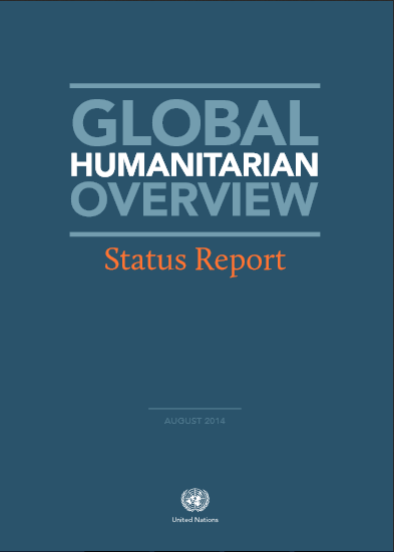Global Humanitarian Overview – Status Report
By United Nations Office for the Coordination of Humanitarian Affairs • August 25, 20142014 has seen a major surge in humanitarian crises around the world. Inter-agency strategic response and regional response plans now target over 76 million people in thirty-one countries compared to 52 million in December 2013. 102 million people are estimated to be in need of humanitarian assistance compared to 81 million in December 2013. Global financial requirements to cover humanitarian needs rose from US$12.9 billion in 2013 to $17.3 billion now. More and more crises are having a regional impact with a spill-over effect on countries which are already fragile.
Five crises have been classified by Principals of the Inter-Agency Standing Committee as “L3 emergencies”. L3s are considered to be the highest level of crisis requiring sustained, top level, system-wide support focused on leadership and coordination to improve the effectiveness of humanitarian response efforts. The response to Typhoon Haiyan in the Philippines was declared an L3 emergency in November. An estimated 11.3 million people in nine regions of the Philippines were affected by Typhoon Haiyan. At least 6,201 people were killed and the force of the storm caused widespread destruction of homes and infrastructure in many towns.
The ongoing L3 emergencies in Syria, the Central African Republic (CAR) and South Sudan are all complex crises which have resulted in significant internal displacement resulting from conflict and ongoing insecurity and the need for protection. They have also become regional crises with political, security, development and humanitarian consequences in their region. In Syria, the number of people in need is estimated to have risen from 9.3 million in December 2013 to 10.8 million now. As many as 6.5 million men, women and children are displaced inside the country and over 2.9 million refugees have fled to Turkey, Lebanon, Iraq, Jordan, Egypt and other countries. The breakdown of law and order and ongoing conflict in the Central African Republic has resulted in more than 518,000 people displaced internally and more than 171,273 people have crossed the border into Chad, Cameroon, the Democratic Republic of Congo (DRC) and the Republic of Congo. Since December 2013, South Sudan faces a looming famine, 1.3 million people are displaced internally and more than 447,000 people have fled into Kenya, Ethiopia, Sudan and Uganda since December 2013. At the rate of escalation of the crisis an estimated 6 million people will either be refugees, displaced inside their country or face severe food insecurity by the end of the year. Most recently, the humanitarian crisis in Iraq has been declared an L3 emergency. Over 1.2 million people have been displaced and are dispersed throughout the Governorates of Neneveh, Salah Al-Din, Diyala, Al-Anbar and Baghdad due to the current conflict. Access to clean water has emerged as a critical, life- threatening problem. Food security is a growing concern.
In addition to the L3s, a number of major crises require ongoing attention. In nine countries across the Sahel, the drought of 2012 exacerbated the devastating cycle of malnutrition and poverty in the region leaving more than 20.2 million people food insecure, of whom 11.9 million people will receive food assistance this year. 2.9 million chil-dren will be treated for moderate and severe acute malnutrition across the Sahel. Rising severe and acute malnutrition rates in DRC and Sudan also require a sustained and strengthened humanitarian response. Some 6.7 million people are food insecure in DRC and 5 million others in Sudan. In DRC, 35 per cent of children’s deaths are attributed to malnutrition. 14.7 million people remain in need of humanitarian assistance in Yemen.
Protection needs remain high in many complex and protracted crises. In DRC for example, protection against sexual and gender-based violence remains a critical area of humanitarian response. Crises in Somalia, Haiti, Myanmar, Djibouti, Sudan, Mali, the occupied Palestine territory and Afghanistan all demand ongoing high level engagement and response. Political upheaval and social unrest have flared into violence in Ukraine and Gaza.
To respond to these ongoing as well as emerging crises, evidence-based, strategic and targeted humanitarian response plans have been developed for each country/region. As situations evolve plans are revised or extended.
To date in 2014 donor partners have enabled 608 aid agencies and their partners to scale-up life-saving operations to support national efforts and help affected people. Details of the flow of humanitarian funding as reflected by the Financial Tracking Service as of 19 August are on pages 12 and 13 of this overview.
The $17.3 billion combined requirements for 2014 represent the highest amount ever requested in a single year for inter-agency strategic response plans and exceed the sum required last year by more than 30 per cent. The majority of requirements are for L3 emergencies. With 43 per cent of funding for 2014 received, another $9.9 billion is required. A pledging conference organized by the Government of Kuwait, a high-level meeting in Brussels and a pledging conference co-organized by OCHA and Norway in Oslo elicited pledges of over $3 billion for the Syria, CAR and South Sudan L3 crises. Efforts will continue throughout the rest of the year to raise the sums required.
Download the full report here.
Tags: Arakan/Rakhine, Buddhism, Human Rights Violations, Humanitarian Assistance, IDPs, Kachin, Muslims, Rohingya, United Nations Office for the Coordination of Humanitarian AffairsThis post is in: Human Rights
Related PostsMyanmar: Free Prisoners of Conscience in Rakhine State End Ongoing Persecution of Rohingya
UN Myanmar Rights Expert: Backtracking on Democratic Space Gains Momentum in Election Year
Myanmar’s Proposed Race and Religion Laws are Discriminatory and should be Scrapped
The FCO’s Human Rights Work 2013
BROUK Welcomes US Senate Resolution on Rohingya










 All posts
All posts